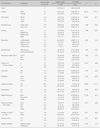Abstract
Purpose
The purposes of this study were to describe the prevalence of low weight and to investigate related factors contributing to low weight in community-dwelling older adults.
Methods
From the database of the Fourth Korean National Health and Nutrition Examination Survey (KNHANES-IV), the researchers selected 2,964 older adults aged over 65. The original study was a population-based epidemiological survey of health and nutrition with a stratified multistage clustered probability design. Data were analyzed using χ2-test and multiple logistic regression with the SPSS/WIN 18.0 program.
Results
The prevalence of low weight in older adults was 4.7%. The prevalence of low weight was different according to demographic characteristics. That is, the rate was higher in male elders, older ones, and rural residents. In the cases of current smoking, frequent alcohol consumption and no chronic disease, the prevalence of low weight was higher. Age, gender, area of residence, and current smoking were found to be contributing factors to low weight in community-dwelling older adults.
Figures and Tables
References
1. Albanes D, Jones D, Micozzi MS, Mattson ME. Associations between smoking and body weight in the US population: Analysis of NHANES II. Am J Public Health. 1987; 77(4):439–444.

2. Barreto SM, Passos V, Lima-Costa MF. Obesity and underweight among brazilian elderly: The bambui health and aging study. Cad Saude Publica. 2003; 19(2):605–612.
4. Cho YH. A study on the related factors and status of body mass index in rural elderly. J Korean Gerontol Soc. 2007; 27(4):897–912.
5. Cope K. Malnutrition in the elderly: A national crisis: A focus on the problems, causes, consequences, and solutions. Seattle: DIANE;1996.
6. Corrada MM, Kawas CH, Mozaffar F, Paganini-Hill A. Association of body mass index and weight change with all-cause mortality in the elderly. Am J Epidemiol. 2006; 163(10):938–949.

7. Donini LM, Savina C, Cannella C. Eating habits and appetite control in the elderly: The anorexia of aging. Int Psychogeriatr. 2003; 15(1):73–87.

8. Dorner TE, Schwarz F, Kranz A, Freidl W, Rieder A, Gisinger C. Body mass index and the risk of infections in institutionalised geriatric patients. Br J Nutr. 2010; 103(12):1830–1835.

9. Kaiser R, Winning K, Uter W, Volkert D, Lesser S, Stehle P, et al. Functionality and mortality in obese nursing home residents: An example of 'risk factor paradox'? J Am Med Dir Assoc. 2010; 11(6):428–435.

10. Kitamura K, Nakamura K, Nishiwaki T, Ueno K, Hasegawa M. Low body mass index and low serum albumin are predictive factors for short-term mortality in elderly japanese requiring home care. Tohoku J Exp Med. 2010; 221(1):29–34.

11. Korea Centers for Disease Control and Prevention. The Third Korea National Health and Nutrition Examination Survey [KNHANES III]. 2006. 07. Retrieved August 22, 2011. from http://knhanes.cdc.go.kr/.
12. Korea Centers for Disease Control and Prevention. The Fourth Korea National Health and Nutrition Examination Survey [KNHANES IV-3]. 2010. 12. Retrieved August 22, 2011. from http://knhanes.cdc.go.kr/.
13. Korea National Statistical Office. Census of elderly population in Korean 2010 year. Seoul: Korea National Statistical Office;2010. 10.
14. Lee SG, Jeon SY, Lee JY. Factors related with low body weight in older adults at a urban-rural composite area. J Korean Gerontol Soc. 2008; 28(1):105–121.
15. Lee JH. Effect of body weight on mental health in the elderly. J Korean Geriatr Psychiatry. 2004; 8:102–106.
16. Lewko M, Chamseddin A, Zaky M, Birrer RB. Weight loss in the elderly: What's normal and what's not. P T. 2003; 28(11):734–739.
17. Manson JE, Willett WC, Stampfer MJ, Colditz GA, Hunter DJ, Hankinson SE, et al. Body weight and mortality among women. N Engl J Med. 1995; 333(11):677–685.

18. Martin CT, Kayser-Jones J, Stotts N, Porter C, Froelicher ES. Factors contributing to low weight in community-living older adults. J Am Acad Nurse Pract. 2005; 17(10):425–431.

19. Thompson Martin C, Kayser-Jones J, Stotts N, Porter C, Froelicher ES. Nutritional risk and low weight in community-living older adults: A review of the literature (1995-2005). J Gerontol A Biol Sci Med Sci. 2006; 61(9):927–934.

20. Martin CT, Kayser-Jones J, Stotts NA, Porter C, Froelicher ES. Risk for low weight in community-dwelling, older adults. Clin Nurse Spec. 2007; 21(4):203–211.

21. Miller SL, Wolfe RR. The danger of weight loss in the elderly. J Nutr Health Aging. 2008; 12(7):487–491.

22. Mineur YS, Abizaid A, Rao Y, Salas R, DiLeone RJ, Gündisch D, et al. Nicotine decreases food intake through activation of POMC neurons. Science. 2011; 332(6035):1330–1332.

24. Nielson CM, Marshall LM, Adams AL, LeBlanc ES, Cawthon PM, Ensrud K. BMI and fracture risk in older men: The osteoporotic fractures in men study (MrOS). J Bone Miner Res. 2011; 26(3):496–502.

25. Shahar A, Shahar D, Kahar Y, Nitzan-Kalusky D. Low-weight and weight loss as predictors of morbidity and mortality in old age. Harefuah. 2005; 144(6):443–448.




 PDF
PDF ePub
ePub Citation
Citation Print
Print




 XML Download
XML Download